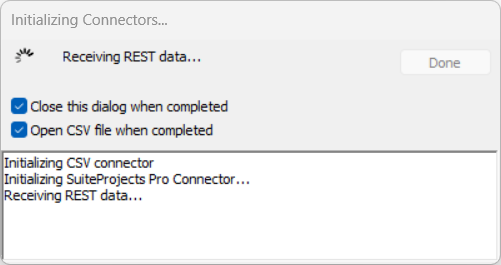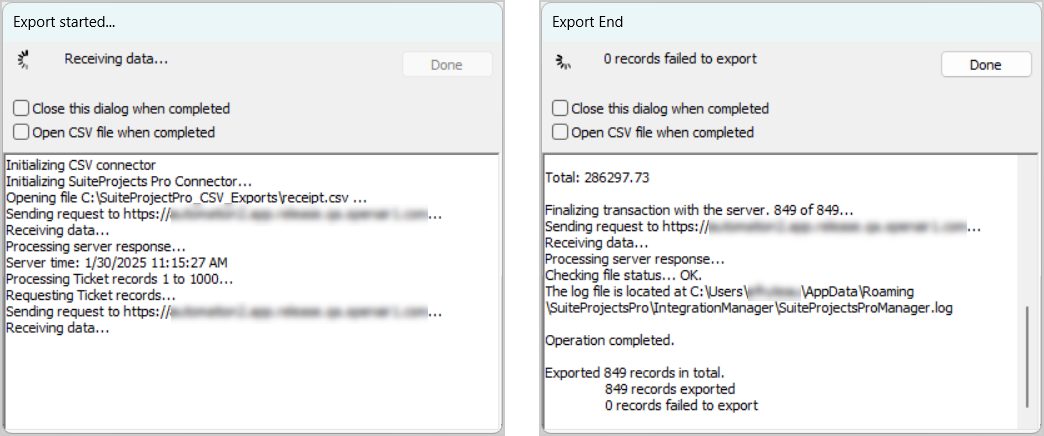Exporting SuiteProjects Pro Data to a CSV File
Integration Manager lets you export your SuiteProjects Pro data to a comma separated values (CSV) file. You can then use this CSV file to import your SuiteProjects Pro data into third-party software such as a productivity application, a payroll system, or an accounting package.
You can export all records of a supported record type or a subset of records, using filtering options. You can select the fields containing the information you want to export and map them to columns in the exported CSV file, include information stored in the custom fields specific to your SuiteProjects Pro account, look up and export information from directly and indirectly related tables in the SuiteProjects Pro database, combine several SuiteProjects Pro fields into one CSV column, add additional information as a CSV column or as header information. You can specify the format of date and time columns in your exported CSV file, and build in some simple length and range validation for field values, or some simple logic to change a target field value in your exported CSV file based on a test field value in SuiteProjects Pro.
To export data to a text CSV file:
-
Launch Integration Manager. To do so, do one of the following:
-
Double-click the shortcut icon on your desktop (if you opted to add the shortcut during installation).

-
Enter "SuiteProjects Pro Integration Manager" in the search box on the Windows task bar, then double-click SuiteProjects Pro Integration Manager.
-
-
Enter your SuiteProjects Pro account and sign-in details. See Connecting Integration Manager with your SuiteProjects Pro Account.
-
Select the character encoding scheme for CSV imports and exports. See CSV Character Encoding.
-
In Integration Manager, identify the type of record you want to export and configure the export. To do so:
-
Map SuiteProjects Pro fields to CSV columns. See Mapping SuiteProjects Pro Fields to CSV Columns.
The field mapping functionality lets you select the SuiteProjects Pro fields you want to export. All supported standard SuiteProjects Pro fields for the selected record type and for directly associated record types are selected for export by default. You can exclude any SuiteProjects Pro fields from your export, change the order of columns in the exported CSV file as well as the column headers. You can also:
-
Include information stored in the custom fields specific to your SuiteProjects Pro account. See Making SuiteProjects Pro Custom Fields Available for Mapping.
-
Include additional information not already available in SuiteProjects Pro as a CSV column. See Making Additional Information Available for Mapping (Calculated Fields).
-
Combine several SuiteProjects Pro field values under one CSV column. See Combining and Splitting Information.
-
Look up standard and custom field values for SuiteProjects Pro records directly or indirectly related to the record you are exporting. See SuiteProjects Pro Field Value Lookup (Export) and Record Lookup (Import).
-
-
Set format options. See Formatting Information for Export and Import.
The format options let you:
-
Specify the format of values containing both date and time parts in your CSV file. See Setting the Date and Time Format Used in the CSV File.
-
Add length and range validation for field values in your CSV file. See Validating Field Value Length and Range on Export.
-
Build in some simple logic using conditional overrides to change a target field value in your exported CSV file based on a test field value in SuiteProjects Pro. See Setting Up Conditional Overrides.
-
-
Set filter options. See Filtering SuiteProjects Pro Records for Export.
-
If you are exporting Receipt, Revenue recognition transaction, TimeBill (charge, slip, or bill), Timesheet entry, or Slip projection records, set grouping and balancing entry settings. See Grouping and Summarizing Record Data and Adding Balancing Entries for Export.
Note:The Grouping and Balancing Entries settings restrict the Field Mapping functionality. Only the standard fields selected for inclusion in Grouping and Balancing Entries are available for mapping.
-
Include header information at the top of your CSV file content. See Adding Header Information to Exported CSV Files.
-
-
Create an Integration Manager shortcut if you want to export records of this type on a regular basis manually without launching the Integration Manager application, or to schedule the export to run automatically. This may be useful to support an on-going integration, for example. The Integration Manager shortcut you create captures the field mapping, filter, format and other settings you configured for this export. See Working with Export and Import Shortcuts and Working with Export and Import Shortcuts.
-
On the main Integration Manager window, select the row corresponding to the record type you want to export
 to a CSV file, then click Start to launch the export process.
to a CSV file, then click Start to launch the export process.A window appear showing the progress of your export.
 Note:
Note:To keep the export progress status window open after the export completes, clear the Close this dialog when completed box. This may be useful if you want to check the status of your export on completion without viewing the log file.
To open the exported CSV file in the default application associated with CSV files on your computer, check Open file when completed.
Next, the Export To CSV File window appears.

-
Select the CSV file you want to export information to. To do so, click the Select icon
 , select the CSV file, or select the location for your CSV file and enter the name if the file does not exist, then click Open.
, select the CSV file, or select the location for your CSV file and enter the name if the file does not exist, then click Open.The Export To CSV File window shows the file path.
-
Select the Delimiter to be used in the exported CSV file from the dropdown options.
-
By default, Integration Manager adds the selected delimiter at the end of each row (record), after the last column. To exclude the delimiter at the end of each row, check the Suppress trailing delimiters box.
Note:Both the CSV delimiter and the optional row end delimiter depend on the third-party application you plan to import the CSV file into and the CSV format it requires.
-
Click OK.
The progress status window shows the detailed progress of your export from start to completion.

-
After the export completes, you can open the exported CSV file.
Note:Spreadsheet applications may interpret certain type of information in your CSV file and change the format of the values. For example, alphanumeric values with leading zeros may be interpreted as number fields and leading zeros may be dropped. To check the format of values in the exported CSV file, open the file with a text editor.